Photographer Tom Hunter stages modernized adaptations of paintings by such icons as Vermeer, Manet and the Pre-Raphaelites by using models and settings from Hackney, the London neighborhood where he has lived for the past 20 years. He also draws upon the Hackney Gazette, the local weekly paper whose clever and sensationalistic tabloid headlines give him titles and narratives for many of his stunning and disquieting images. When Hunter arrived in Hackney in the 1980s (he still lives at the same address, just outside London Fields) the area was, in his words, a "total wasteland which became like a village." The area has no local tube stop, and its inaccessibility led its close-knit community of squatters to develop their own do-it-yourself (DIY) artistic, cultural and social life. As in New York's Soho in the 1980s, or Williamsburg, Brooklyn a few years ago, Hackney residents recycled rundown buildings amidst pockets of lawlessness; built and ran roving cafes; staged cinema nights in their homes; threw impromptu parties and raves; and organized exhibitions in empty spaces without the official oversight or funding that bureaucratized the creative culture of more gentrified areas. Yet the press focused on the neighborhood's high crime rate. Ignoring the positive aspects of Hackney's local life, it sensationalized the area's violence, poverty, drug-use and deprivation, particularly among the large and vulnerable immigrant communities. Hunter, who was born in rural Dorset in 1965 and received an MA at the Royal College of Art in 1997, currently exhibits with White Cube gallery in London and New York's Yancey Richardson gallery. His current exhibition, "Living in Hell and Other Stories"' is the first photography exhibition to be shown at the National Gallery.
Why did you choose to address contemporary subjects using the poses and style of well-known art historical images?
When I started looking at the Dutch masters, I decided to use the same strategies and highlights they used when depicting ordinary people, instead of the monarchy or mythological figures. I wanted to uplift the status of my subjects, so I started taking large pictures, and when people saw them, they started looking at the lives I was representing differently. Just as in Vermeer’s day, the people were fighting oppression. When I started working, we, as in the squatters, were fighting for independence from the Hackney council, and by my showing my neighbors in Vermeer poses, people started looking at them not as victims or perpetrators or criminals but as important people with dignity.
Do you think most viewers see art history as precious and irrelevant?
Definitely. That is another reason I wanted to work this way. I wanted people to look at the photographs and see history happening today, but also look back at the paintings and see that those paintings were not just about brushstrokes, color and light, but also about reality—stories of violence, people living in service. But when people go to a museum and they are told to be quiet and not use their mobile phones, they start to see paintings as things that are distant, things to be worshipped, not looked at.
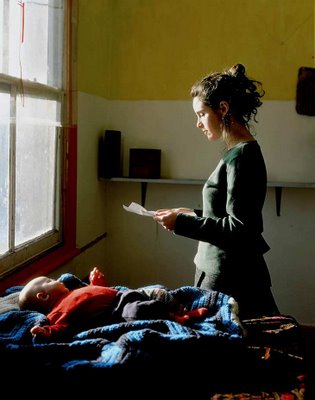 Woman reading a Possession Order, based on Vermeer's "Girl Reading at Window"
Woman reading a Possession Order, based on Vermeer's "Girl Reading at Window"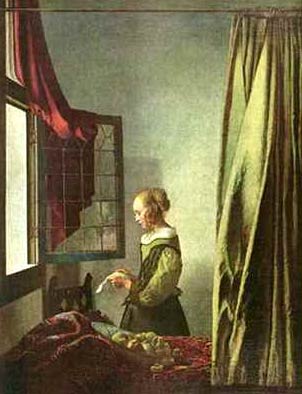
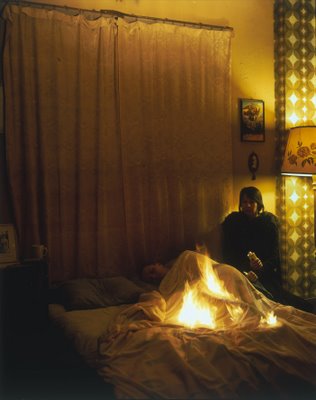
"Lover Set on Fire in Bed"
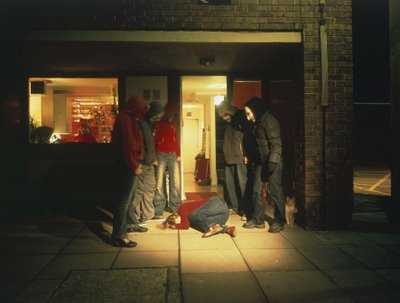
"Hallowe'en Horror: Trick or Treat Thugs break Mum's Bones"
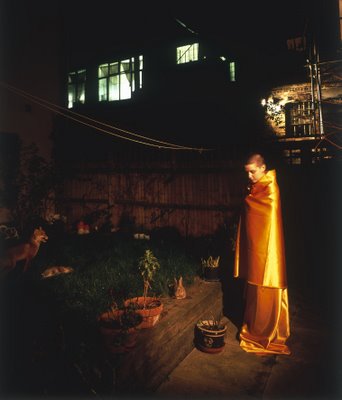
"Bounding Buddhist rushes to the Rescue of Neighbour's Pet"
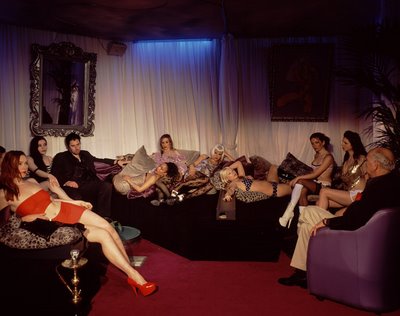
"Father and Son run £2m Vice Racket"

5 comments:
I love the idea of making paintings into photographs. It makes me happy in the same way as seeing a good comic turned into a movie. Because to me, the more mediums for a peice of art, the more interest, not only in the new peice of art but the original as well. I think my favorite is either "Woman Reading a Posession Order" or "Father and Son run L2m Vice Racket". Again, I admire Hunter's careful planning.
"...they start to see paintings as things that are distant, things to be worshipped, not looked at."
I like the way he thinks about artwork. When you go to a museum the artwork is literally and figuratively untouchable. There is no way to relate. He shows how attainable artwork of this caliber can be. He doesn’t make it sound easy but, with enough planning and thought, just as if you were going to paint a scene, a photograph can be as significant as a painting hanging in the museum.
It is also interesting that he pulls from paintings that we are somewhat familiar with so that there can be a sense of comfort and appreciation when viewing his art.
I'm happy that he didn't use period clothing, that it's simply posed photos from the past in modern settings. These are beautiful, and compositions successful but I supposed all that work was done hundreds of years ago. I really am forced to look at these images as more than just photographs because of this new manner in which it's shot.
Another way that the modernization of works acts as a commentary on our world. Taking works such as "gril reading at a window" and turning it into a modern situation really talks about the advances - or degeneration of our modern life.
His photos of paintings, make the image more tangible, more realistic. They have a depth of field and clarity that painters cannot create. He takes the past and transforms it into something relevent today. It makes the viewer more connected to the art b/c they have a sense of something you might see going on as you walk down the street or peek into someone's window.
Post a Comment